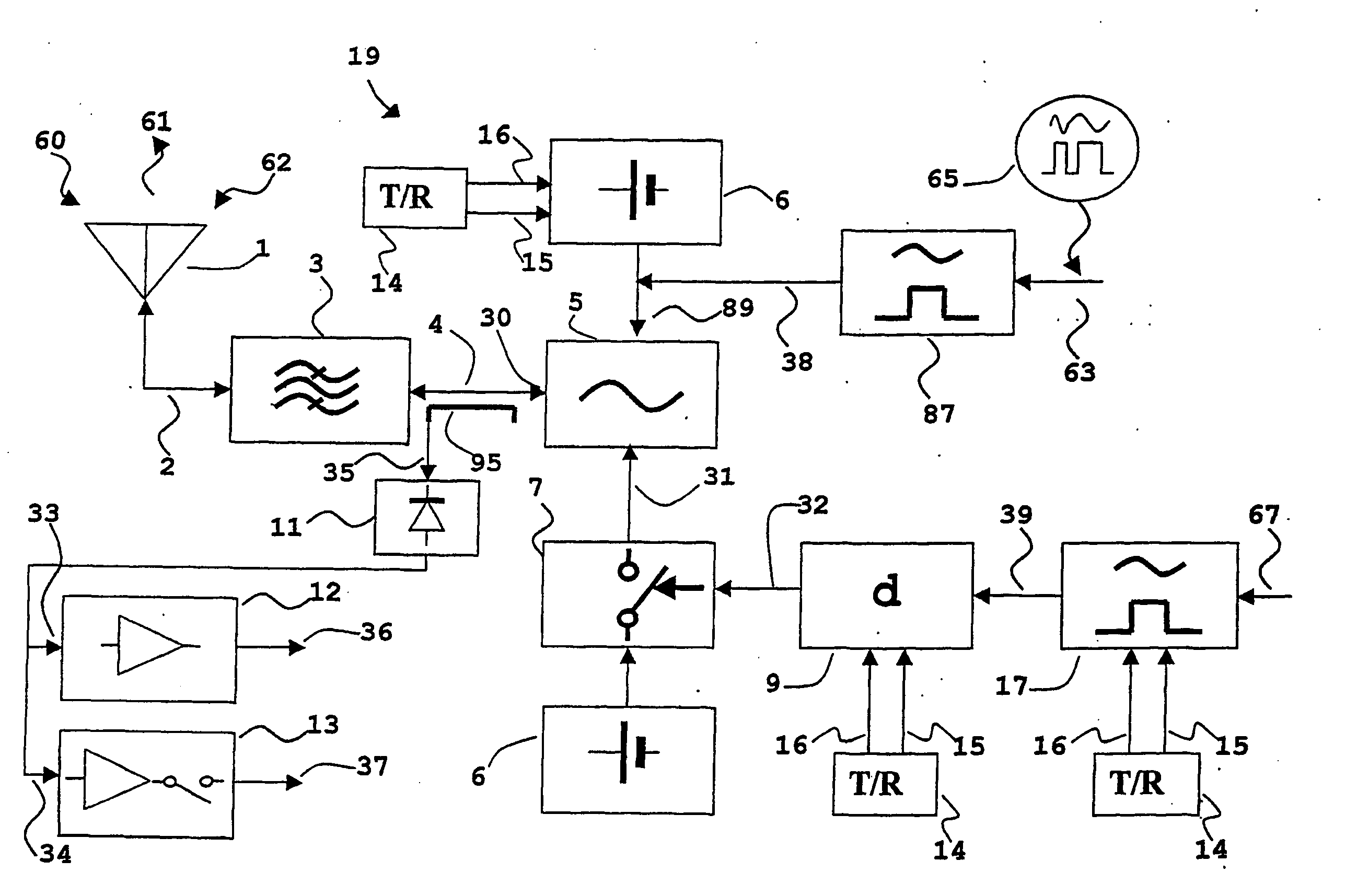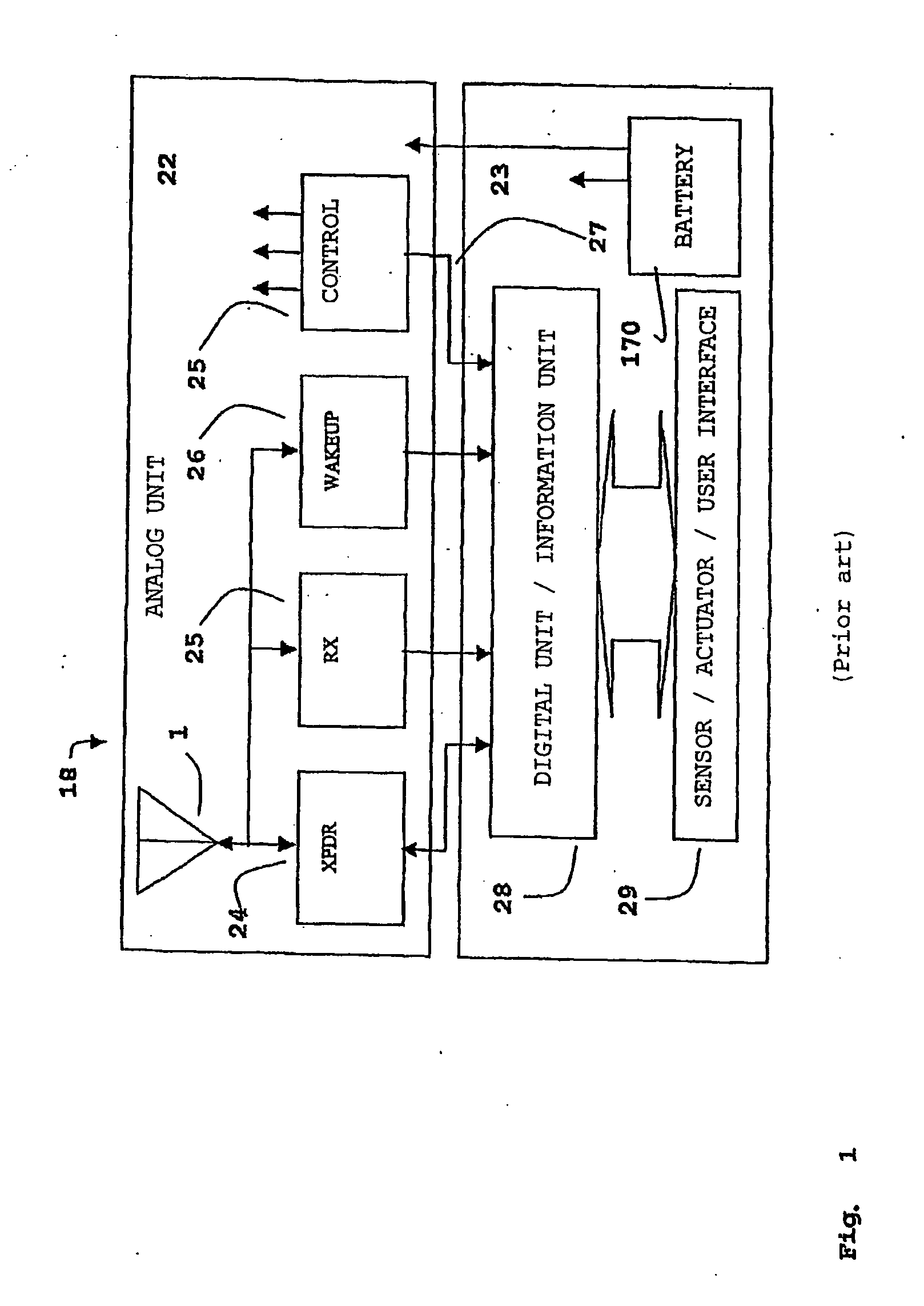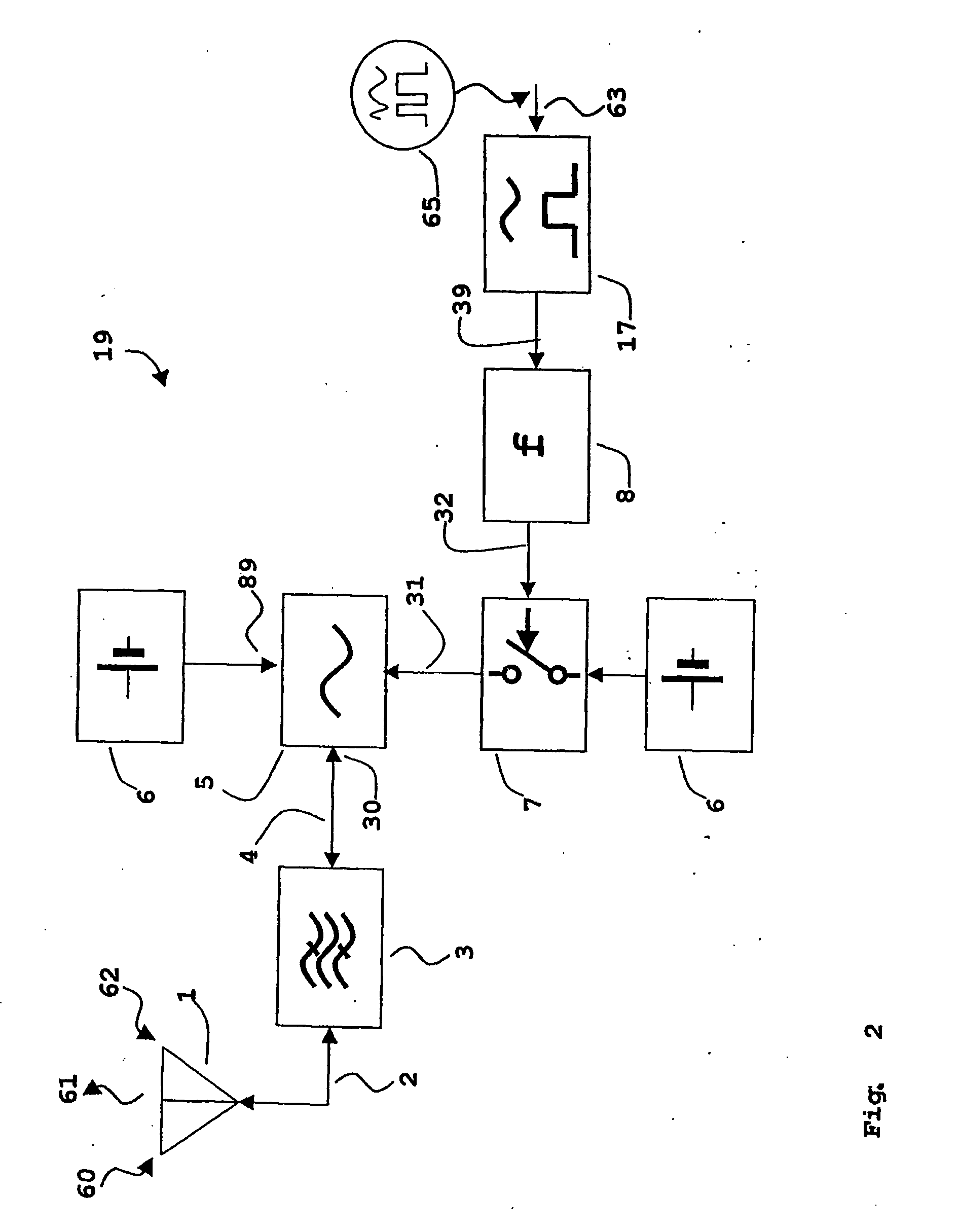Such transponders therefore, serve few applications within the various areas of
wireless communication and
radio navigation.
It is frequently required that the transponder is portable, lightweight, compact, simple and carries few components, is inexpensive to manufacture and has several years of battery life, at the same time as available performance margins become inadequate, especially with respect to communication range.
Too much
antenna gain is unwanted, because high
antenna gain gives too narrow antenna lobes and consequently pointing errors, and the result may therefore become losses in stead of
gain.
With conventional technology this comes with high costs in the form of high
power consumption and costly products.
Power consumption becomes high because unconditionally stable amplifiers are required.
Cost becomes high because this, on
microwave frequencies, usually is accomplished with
microstrip technology and expensive circuit board laminates.
The amplification achievable is very limited due to current draw and because it is difficult to sustain sufficient isolation between
transmitter and
receiver in low cost products.
Benefits of such solutions are usually not worth the increased cost, and the majority of such products today therefore have passive
microwave modules, that is just one
diode or a
transistor switch.
Harmonics of the RF carrier are often very difficult to suppress sufficiently to meet standard requirements.
Transponder range for the transponder solutions mentioned is very limited, because the outgoing signal amplitude is nearly proportional to the incoming signal amplitude as a consequence of no or little active
high frequency amplification in the circuit.
Such amplifying transponders therefore have seen few applications within the various areas of
wireless communication and
radio navigation concerned.
A significant
disadvantage with this solution is that it will require a
crystal oscillator for the
transmitter if the purpose is not served by the poor frequency stability and calibration otherwise resulting.
These have specifications that seriously limit their applications.
One example of
injection locked oscillator application is in phased antenna arrays, but there, as well, the usefulness is limited on account of narrow locking bandwidth which typically will be some ten thousandths of the carrier frequency, and in addition a CW signal is required.
Still, the locking bandwidth is narrow, typically some thousandths of the carrier
wave frequency, and still a CW signal is required, often limited to FM modulated CW, to allow signal repetition to work satisfactorily.
Besides, the locking is heavily dependent on the signal dynamics and will generally only work for strong CW signals.
Another reason is that it is a far more difficult challenge to make a quenched oscillator work according to the intention in superregenerative mode than in
injection locked mode, due to added component requirements besides design challenges.
In addition, the quench frequency is often injected in such a way that the superregenerative
dynamic range is severely limited, which again shows how poorly the circuit was analysed.
The quenched, injection locked (=locked) oscillator has, as explained herewith, specifications that imply large limitations with respect to signal dynamics and bandwidth and further disadvantages like reliability, that reduce possible applications.
This is proven by the fact that earlier publicised and patent text technologies having failed to succeed in applications (i.e. see U.S. Pat. No. 3,705,385), which is due to several factors, some of the more important ones being unreliable frequency locking and narrow useful information bandwidth in the kilobaud range.
Such bandwidth is mostly rather uninteresting for today's communication technologies.
One application for simple transponders in RFID which include long range, is radio tagging of animals, where limited range for today's transponders makes them less suitable and therefore other technologies are used like pulsed beacons that renders less service per carried energy unit because continues transmission is required.
The evolution of radio based, wireless networks for large bandwidths that is required to use very high frequencies (10-200 GHz) have been hampered by the fact that it is still too expensive to implement transmitters, receivers and transceivers.
Up to now, it has not been possible to realise a simple transponder with large dynamics for such frequencies.
Line amplifiers are expensive to realise and often they can amplify the signal in one direction only.
Examples of line amplifiers that have high amplification, but are unidirectional are cable TV amplifiers used for data communication.
For
high frequency it has been possible to make line amplifiers with limited isolation between the
amplifier input and output, with resulting low useful amplification and therefore applications are very limited.
This puts strict requirements on real
time processing and filtering, and often reduces the update rate of the
system.
Until now, such transponders have been too expensive to make or have not been realisable.
This has been excessively expensive and may cost tens of thousands of US dollars per connected unit.
It follows that there can be only a small number of amplifiers along the lines, resulting in a very low
communication bandwidth.
Likewise, it is expensive and complicated to bypass transformers and other infrastructure in the power network for communication signals.
With known technology it is not possible to have distributed surveillance along a power line and existing solutions therefore use expensive, widely spaced installations that use radio communication There is therefore a need for a new technology which integrates all types of surveillance and control in any position in the
power line network, with
two way communication along the power lines.
Line amplifiers are very expensive to realise and install and indirect repeaters reduce the data bandwidth.
Consequently it is often difficult to transmit signals between clients and other units like routers, masters and hubs.
Here, it has until now been impractical to realise inexpensive transponders or
repeater systems to amplify the signals in a simple manner and in such a way fill in coverage holes or shadow zones.
Known technology did not achieve the necessary
signal amplification and one therefore was obliged to install an additional
base station to serve a coverage hole area.
Such insufficient coverage therefore had to be accepted as along roads, within buildings, ships, ferries and so on.
With known technology, it is neither easy nor cost effective to couple shielding rooms in buildings, ships a.s.o. to the outside world to achieve
radio coverage.
In other communication systems where passive
RF technology or low transmitting power is used, like in RFID tags, the margins often are small giving communication problems from changing conditions of various kinds.
 Login to View More
Login to View More  Login to View More
Login to View More 


